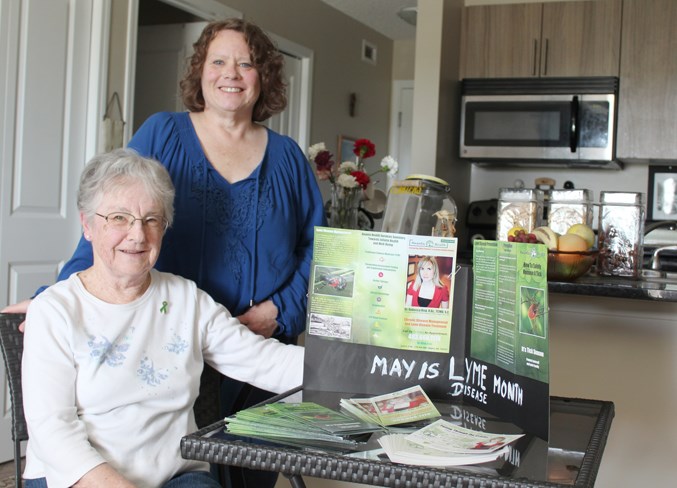Much is often shared between mothers and their daughters. Unfortunately for DeLores Duris and her daughter Barb Fehr, their familial link also extends to chronic illness in the form of Lyme disease. It was only two weeks ago that their combined decades of unexplained pain and discomfort was officially attributed to disease-carrying deer ticks (blacklegged ticks), when both women received their positive Lyme tests through a Calgary clinic that specializes in Lyme disease treatment - Ananta Health. The women join an unconfirmed and growing population of Lyme disease sufferers, who contracted the Borrelia burgdorferi bacteria transmitted through tick bites to human flesh. The Public Health Agency of Canada’s statistics, which are believed to be "vastly under reported" according to the Lyme community, reveal reported Lyme cases have risen to 962 in 2016 from 144 in 2009. Alberta has been slow to acknowledge that Lyme can be contracted within the province, while Lyme sufferers scoff at the notion that ticks could possibly know borders. May is Lyme Awareness Month and the return of migratory birds carry with them a need for enhanced awareness that the once-thought of rare disease is becoming increasingly prevalent, with speculation as high as one in four ticks could be carrying the Lyme-causing bacteria. "If you believe in science, you believe in Lyme," explained Dr. Rebecca Risk of Ananta Health - a Traditional Chinese Medicine (TCM) practitioner who is also a Lyme sufferer. Nearly 40 now, Risk said she was bit by ticks at ages five and 16 - the latter bite eventually led her to be bed ridden with debilitating symptoms, including ones that mimicked seizures. Years of specialists led to isolation, fueling her journey that led to her own recovery to wellness through TCM and supplementation and a career path that is dedicated to helping others who live with chronic pain, specifically Lyme. "The Canadian test is only about 30 per cent accurate," she said, explaining why she sends her Lyme tests to Germany for more thorough testing - cellular ELISPOT testing through Armin Labs. According to Risk, who has been a TCM practitioner since 2006 and has treated thousands of Lyme sufferers, around 20 per cent of those treated with antibiotics after getting bit by a tick are insufficiently treated - where the Lyme becomes chronic. Risk focuses on working with those who suffer from chronic illness as a result of Lyme - those who "fall through the cracks" (what her weekly radio show is aptly named after). Duris and Fehr are among those who have fallen through the cracks. "I knew nothing about ticks," said Duris, 83, as she reflects on her 18 years spent on a farm near Stettler beginning in 1978. Looking back at that time, she remembers working in her large creek-side garden bed and rendering bites that looked different than mosquito bites. By 1986, she began to suffer from extreme mid-back pain on her left side. This pain spread to her left calf and would come and go and left unexplained by medical professionals. This led to further debilitating pain and health concerns, including numbness in her left foot, chronic insomnia, brain fog and heart issues. It was one year ago in May 2017, as May is Lyme Awareness Month, that Duris stumbled across an article in the Cochrane Eagle on a local woman Nancy Doyle and her debilitating struggles of life with Lyme. "Her life felt like my life," said Duris, carefully unfolding the article that triggered her to further explore her own inkling that she, too, suffered from Lyme. She was also concerned that her 55-year-old daughter could also be living with chronic Lyme. Fehr, who has battled a host of unidentifiable health concerns for many years - namely chronic pain, discomfort and chronic fatigue over the years - had been undergoing concerning brain fog, where she was forgetting simple words in spite of having an expansive vocabulary. "It was getting scary and embarrassing," she Fehr, who laughed that she always found a way to blame her ailments on something else as her symptoms mimicked those linked to other diseases or were even flu-like at times. "I always had aches and pains ... you just learn to live with it." "I don't ever remember getting bit ... it's good to finally know what it is, to have a name for it," said Fehr. Earlier this year, the women began attending the Ananta Health clinic, working with Risk through her TCM modalities and supplements, combined with dietary changes. They are hopeful that relief is on the horizon and are hopeful increased public awareness will help evolve the Canadian medical system to take a more proactive approach and prevent people from falling into a never-ending cycle of unknown and chronic health failure. To learn more about supports and services related to Lyme, visit canlyme.com. How to remove a tick: never twist According to both Ananta Health and The Public Health Agency of Canada, ticks should be carefully removed with tweezers. They should never be twisted, which can cause parts of their mouths to break off. Remove the tick in a clean motion and place in a vial, to be taken in to a clinic for Lyme testing. Check the wound for any remaining parts of the tick, clean the area and wash your hands. If sending a retrieved tick to the Alberta Health Services tick surveillance program through mail, double them up in a second ziploc bag. They can be kept alive by placing a blade of grass in the container. Mark the container or bag with date and location of of where it was found. Vets also participate in the tick surveillance program. Learn more at health.alberta.ca. Tick bite symptoms -pain or swelling at the bite site -"bullseye" rash (less common than traditionally believed) -blisters -difficulty breathing -full body rash -headaches -nausea -severe fatigue, muscle and joint aches and pain -fever and/or chills -swollen lymph nodes




